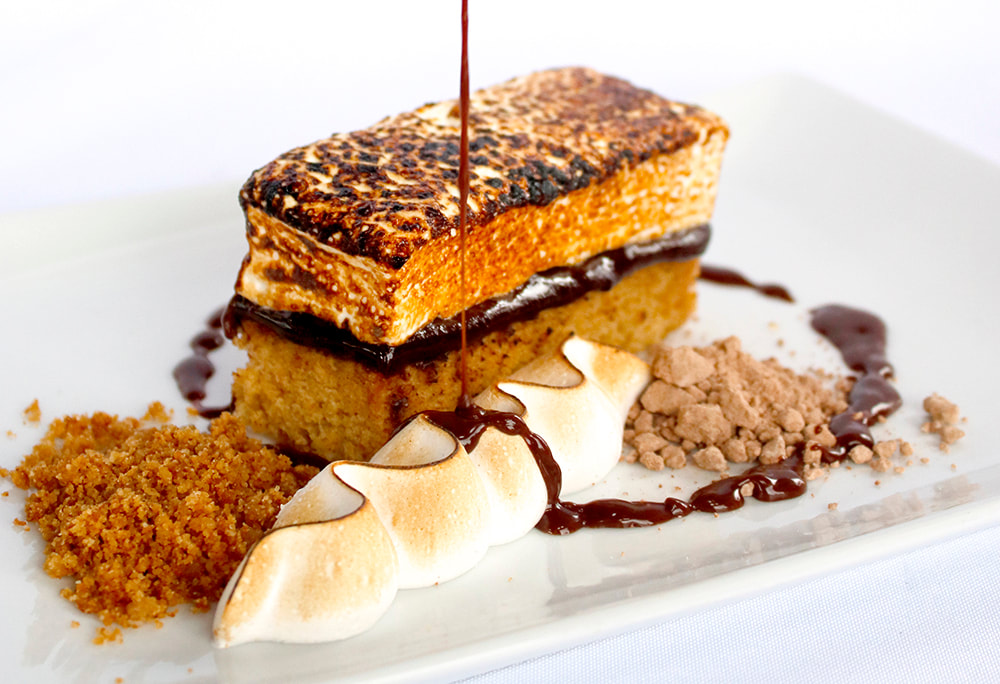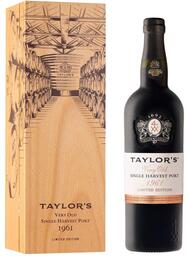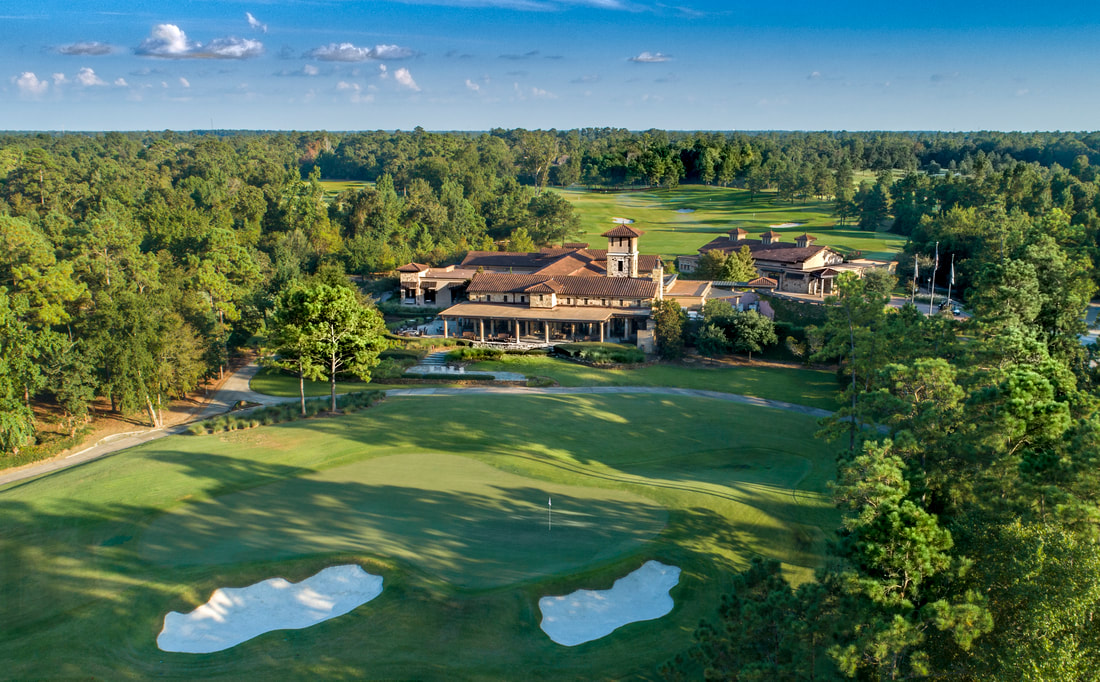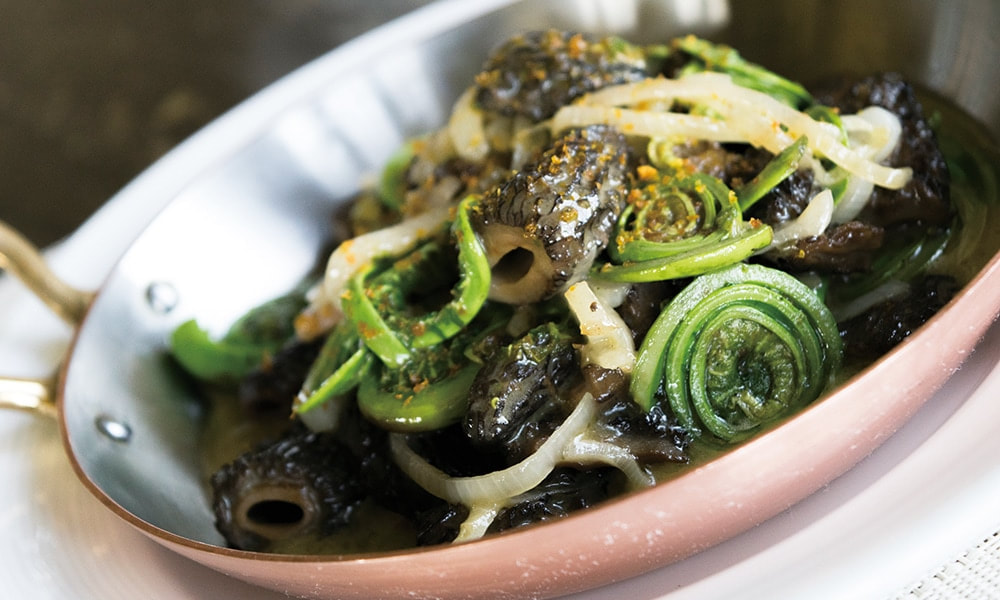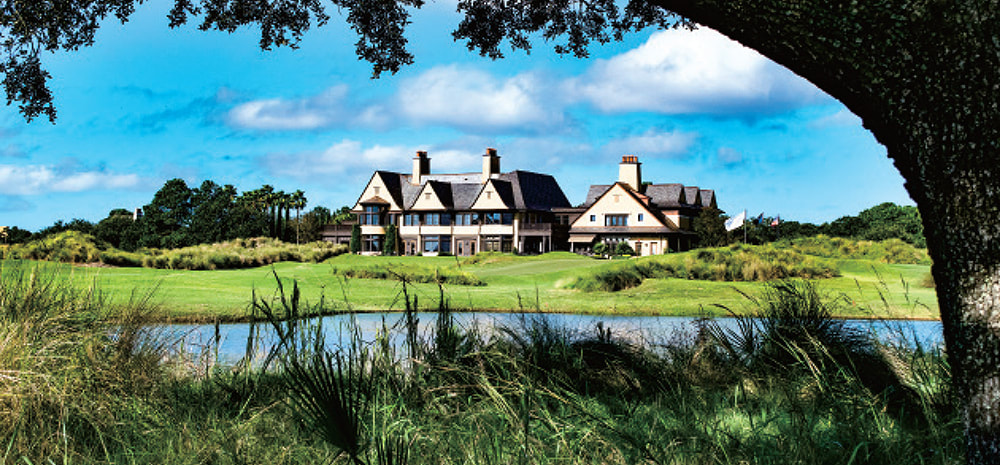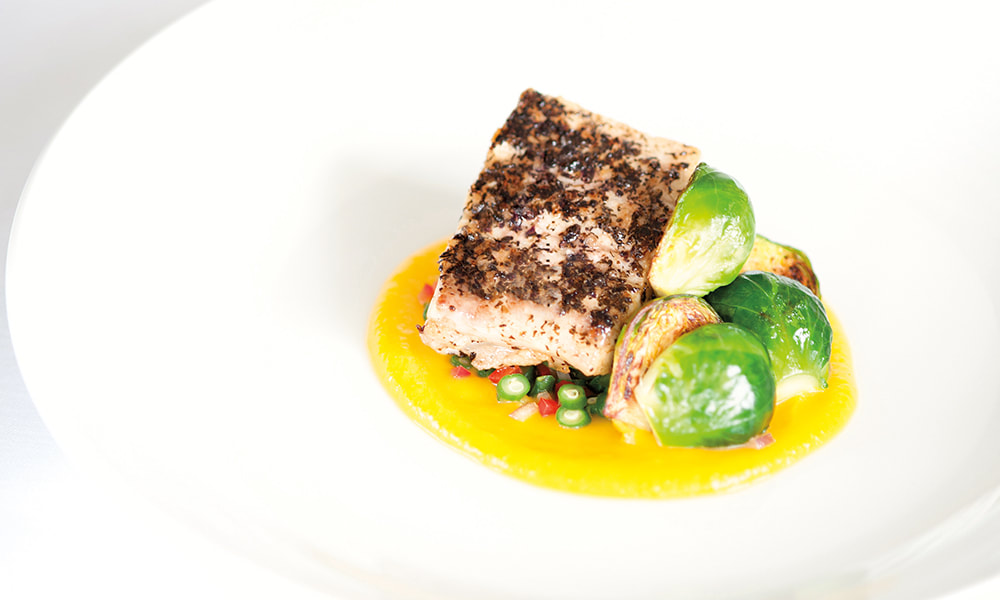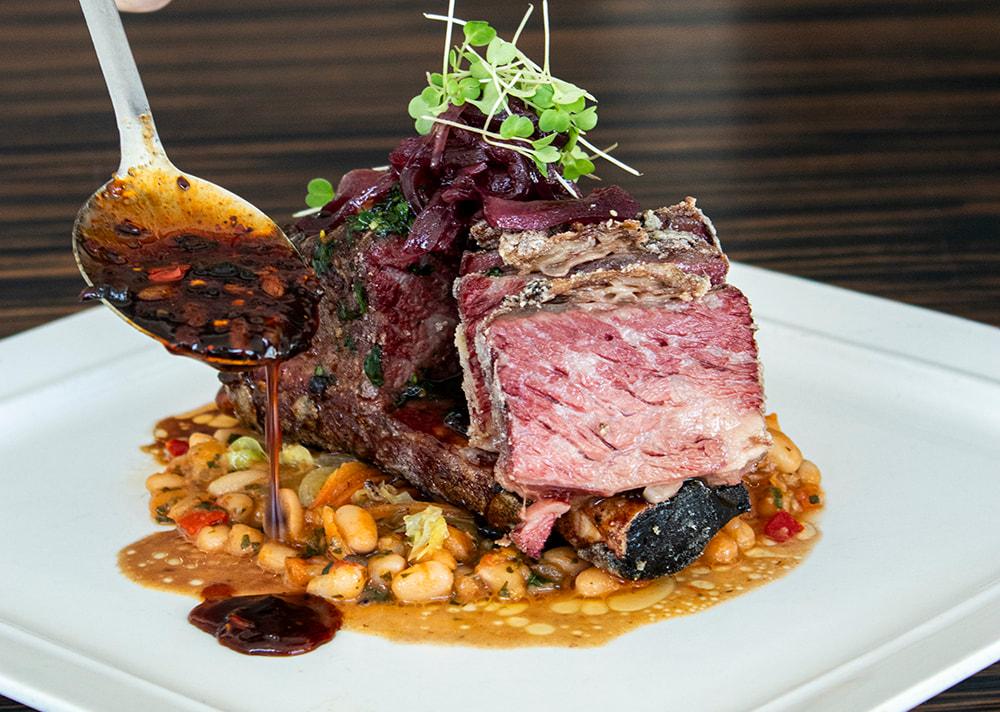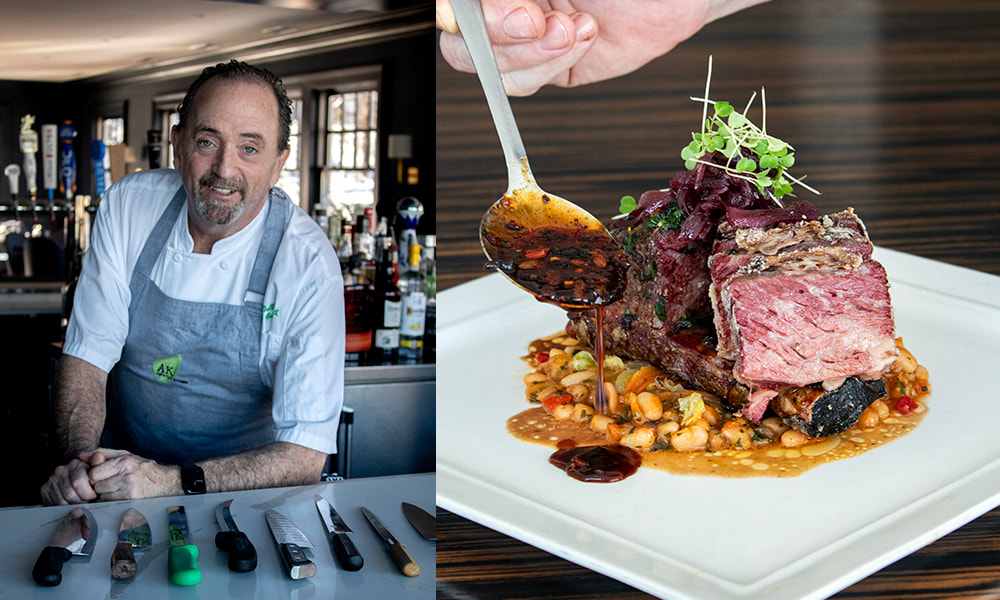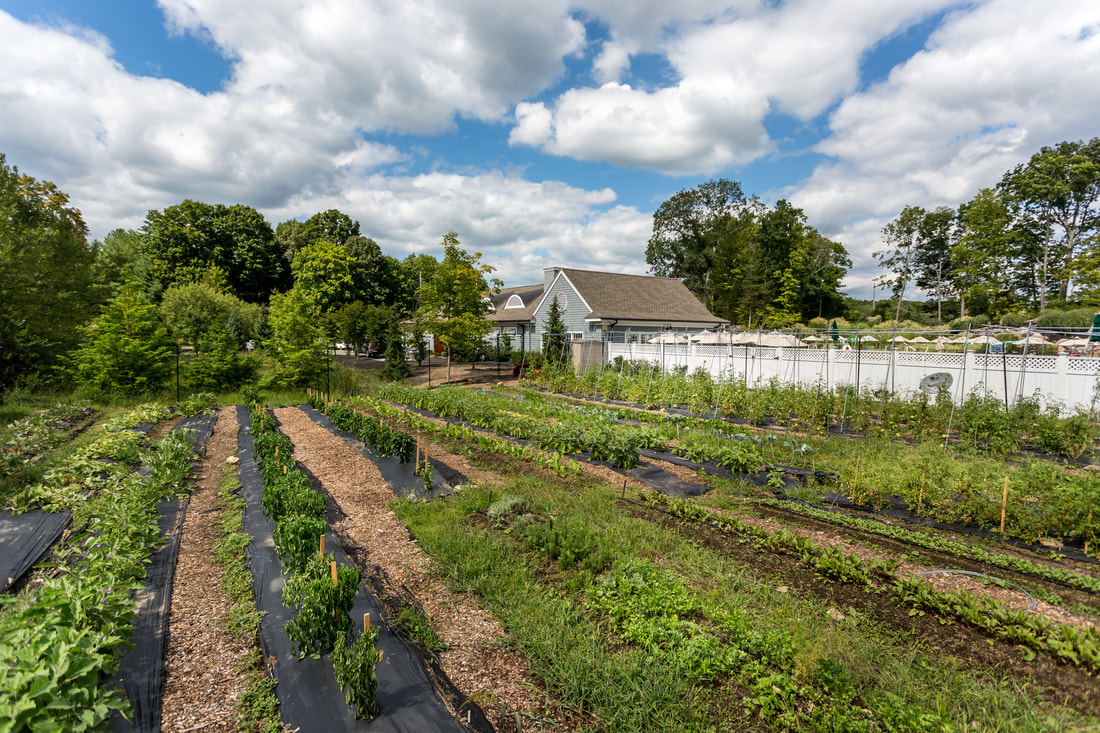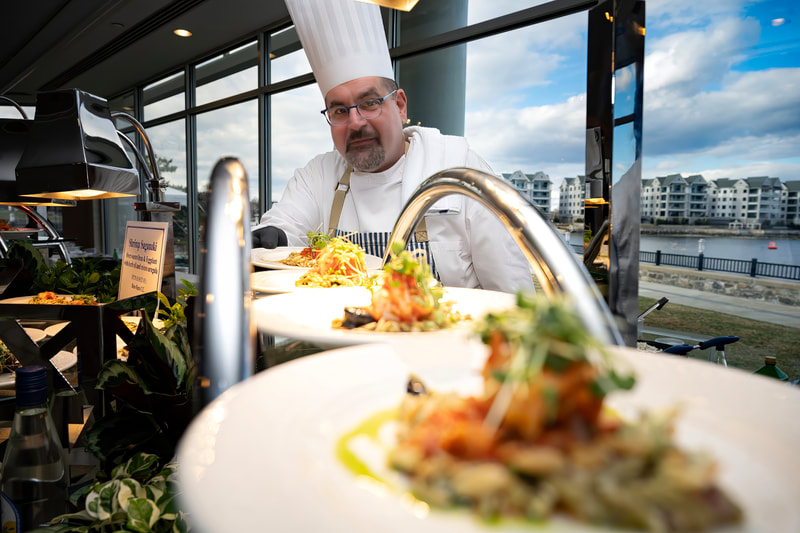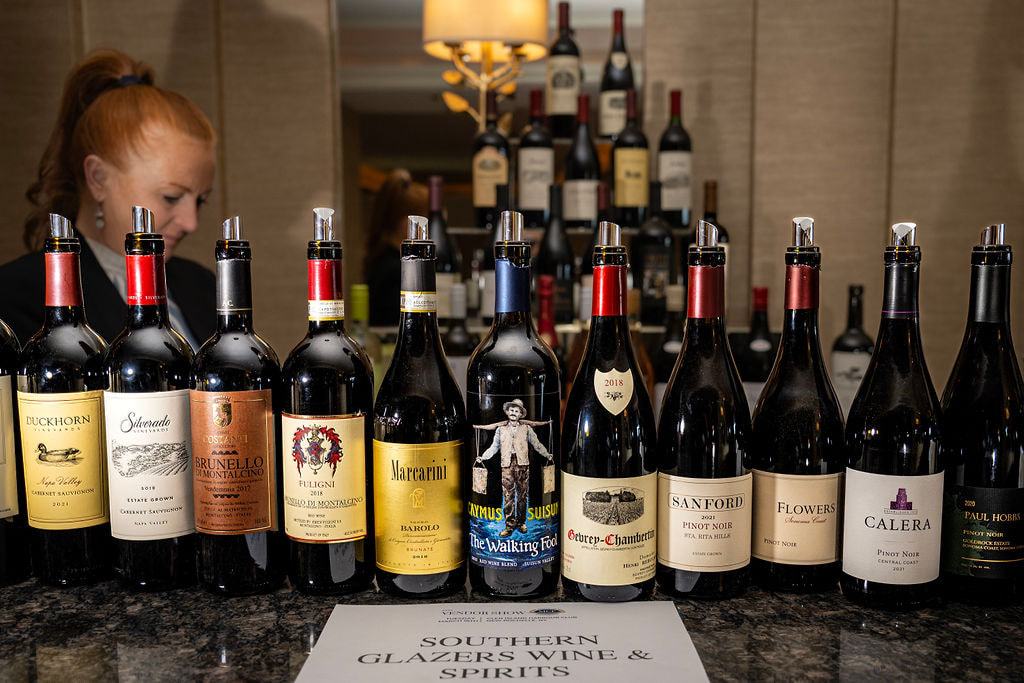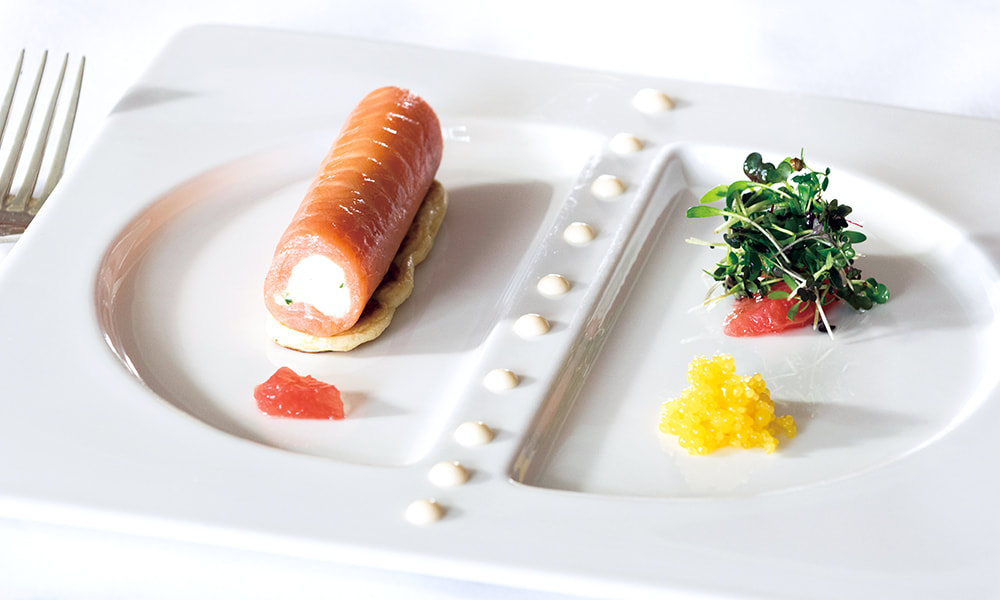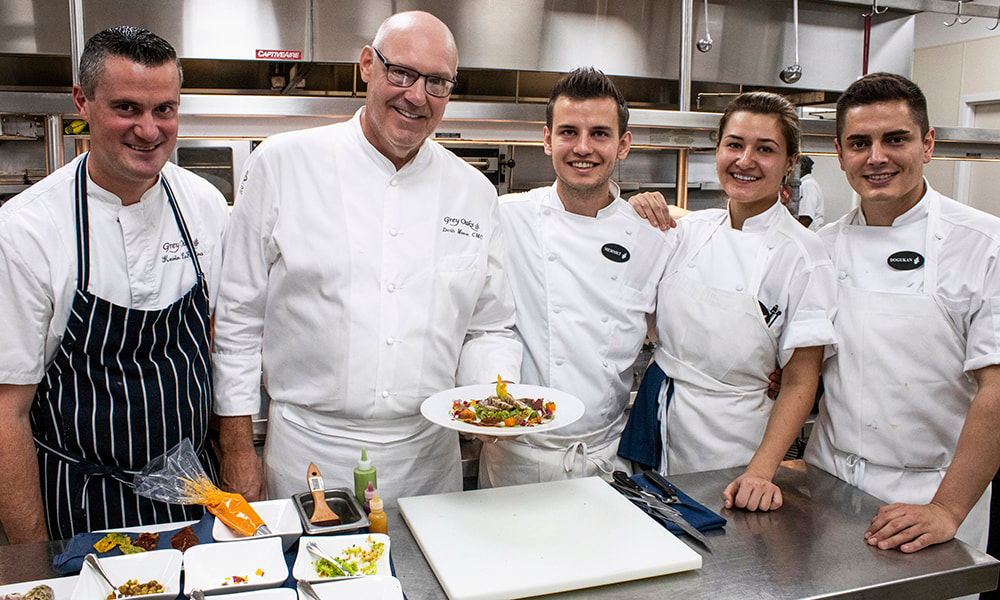|
Recipe by Wes Tyler, Executive Chef and Vanessa Tristan, Executive Pastry Chef at The Club at Carlton Woods, The Woodlands, Texas, USA Image by Diana DeLucia The first marshmallows trace back to a plant called Marshmallow Root (Althaea Officinalis), used by ancient civilizations like the Greeks and Romans for medicinal purposes. The French transformed marshmallows from a medicine into a treat by combining root juice with eggs and sugar, creating a soft paste known as Pâte de guimauve. However, this delicacy was expensive and labor-intensive. In the 19th century, New Jersey Presbyterian minister Sylvester Graham invented Graham Crackers; then, people ate bleached, processed grains. Graham preferred unbleached wheat flour, which he used to promote his unique baking process using unbleached wheat flour. Thus, the graham cracker was born. The precursor to today's s'mores appeared in Victorian-era funeral cakes, sometimes including chocolate and marshmallows. In the 1890s, marshmallow roasting became a fad in Northeastern summer resort towns, often serving as an "excellent medium for flirtation." Mallomars (s'mores in cookie form) hit shelves in 1913, followed by moon pies—a close s'more cousin. But it wasn't until 1927 that the combination of roasted marshmallows, chocolate, and graham crackers officially arrived. The Girl Scouts featured it in their guidebook, cementing the s'more as a timeless campfire classic. In this recipe, Wes Tyler, Executive Chef, and Vanessa Tristan, Executive Pastry Chef at The Club at Carlton Woods, have created their own much more sophisticated version and called it "Contemporary S'mores." ~ Diana DeLucia Yield: 1 Ingredients
Marshmallow
Graham Cracker Cake
Hard Ganache
Cinnamon Marshmallow Fluff
Soft Ganache
Van Leer Chocolate Crumb
Graham Cracker Streusel
Preparation Marshmallow In a heavy-bottomed saucepan, add half of the water, granulated sugar, light corn syrup, and salt and heat medium heat until it reaches 240°F. Mix the corn starch and powdered sugar in a stainless steel bowl. While the sugar mixture is on the stove, in a mixing bowl with the whisk attachment, bloom the powdered gelatin with the remaining cold water. Spray a standard-sized sheet pan with non-stick spray, and cover the pan with the cornstarch and powdered sugar mixture. Chef Note: This will ensure the marshmallows can be easily removed from the pan. When the sugar mixture reaches 241°F, turn the mixer to medium-high and slowly pour it into the bowl with the bloomed gelatin. Keep mixing on high, until your bowl is no longer hot, about 15 minutes. The mixture will melt the gelatin, and it will start to get stringy and fluffy like marshmallow fluff. With disposable gloves on, spray both hands with non-stick spray and place the marshmallow mix onto the prepared sheet pan. Gently press marshmallow into the pan to create a flat surface, spraying your hands more if needed so that the mix doesn’t stick to your hands. Once the marshmallow is flat, heavily dust the top with the cornstarch and powdered sugar mix. Let rest at room temperature for 5 hours or overnight. When the marshmallow is set, cut into rectangles 1.5”X 4”, thick. Chef Note: This will be the topper to the graham cracker and hard ganache base of the contemporary s’mores dessert. Graham Cracker Cake In a mixing bowl with the paddle attachment on medium-high, cream the sugar, salt, and butter until it is light and fluffy, about 4-6 minutes. Slowly add the eggs one by one, making sure the previous one is incorporated; before adding the next one, scrape the sides of the bowl to make sure everything is incorporated. When the eggs are thoroughly mixed, add the vanilla extract. Mix the flour and baking powder, and add this to the egg mixture in the bowl in parts of two with the mixer on low speed. After the flour is very well combined, add the graham crumbs. Finally, add the room temperature milk and continue to mix. Scrape the sides of the bowl one final time and mix for one minute on medium speed or until the cake batter looks nice and creamy. Spray with non-stick spray a standard-sized 1/4 sheet pan and place parchment paper in the bottom. Add your cake batter and bake at 325°F for about 20 minutes, or until the cake batter does not stick will be large chunks of the chocolate/sugar mix, but these can easily be crushed into smaller pieces using a food processor. Graham Cracker Streusel In a medium stainless steel bowl, mix the granulated sugar and the brown sugar until very well combined. Then add the All-Purpose flour and Graham Cracker Crumb. Using a cheese grater, grate the butter into the dry ingredients, making sure not to let the butter clump together. Lastly, add the vanilla with your hands and gently rub everything together until the vanilla is incorporated into the dry ingredients. Place the streusel in a standard-sized sheet pan and bake at 325°F for about 25-30 minutes, or until golden brown. Set aside and let cool. Assembly Place preformed s’mores cake in the center of the dish of choice. Gently pipe ribbons of marshmallow fluff on top of the cake. Garnish with van leer chocolate crumb and graham cracker streusel on either side of the s’mores cake. Chef Note: Serve with warm chocolate ganache, pour-over tableside. Wine Match 1961 Taylor Fladgate Tawny Port, Porto, Portugal A recent release from legendary winemaker Taylor Fladgate, this wine has been aging in barrels for 60 years before its release in 2021. Evocative notes of dried fig, toasted cinnamon, and smoked clove are the perfect complement to a dish that’s so evocative of being beside a campfire. ~ Kyle Holmes, CS, CMS Fazio clubhouse and course. Image courtesy The Club at Carlton Woods.
0 Comments
Recipe by Doug Blair, Executive Chef at Cassique at Kiawah Island Club, Johns Island, South Carolina, USA, 2015 The arrival of spring in the USA marks the beginning of the much-awaited morel mushroom season, which is a source of excitement for foragers and food enthusiasts alike. Morels, a type of elusive fungi, typically emerge from March to May, depending on the region. With the blooming of the first dandelions and the budding of apple trees, it's the perfect time to start searching for these prized mushrooms. Morel hunters eagerly await the first sightings of these much-coveted mushrooms with anticipation. Whether you are an experienced forager or a curious beginner, the morel season offers the promise of culinary delights. You can take a basket and explore the woods, where morels await discovery. It is important to note that morels are a delicacy, and their appearance can be unpredictable. However, the moment you find your first honeycomb-capped mushroom is truly joyous. So, stay informed and enjoy the thrill of the hunt! ~ Diana DeLucia Serves 3-4 Ingredients Fiddlehead Ferns
Fondue
Preparation Fiddlehead Ferns Blanch the fiddlehead ferns in salted boiling water for 30 seconds, then chill in ice water. Fondue Add the water in a small saucepan on medium heat, then gradually stir in the butter until it's emulsified. Season with salt and pepper and add the rest of the ingredients, squeezing the juice of the lemon into the fondue. Simmer for 7 minutes. Assembly Remove all the solids from the fondue with a perforated spoon and place in a serving dish. Chef Note: The fondue can be saved for future use. Garnish with the rosemary sprig from the fondue and serve. The Clubhouse at Cassique at Kiawah Island Club, Johns Island, South Carolina, USA, 2015
Recipe by Jay Matsukawa, Executive Chef at Royal Hawaiian Golf Club, Oahu, Hawaii, USA, 2015 Serves: 1 Ingredients
Kabocha Pumpkin Purée
Preparation Season the Hawaiian Kampachi with the soybean oil, and Hawaiian rock salt on all sides, and just the presentation side with the Yukari flakes. Bring a saucepan to medium-high heat and sear the Yukari side of the fish. Flip and cook to your desired temperature; set aside. Quickly sauté the Brussels sprouts in the same pan and season with salt and pepper, set aside. In a small bowl, toss the long beans, onions, red and green peppers, and extra virgin olive oil; season with salt and pepper. Kabocha Pumpkin Purée Combine all of the ingredients in a heavy-bottomed saucepan. Bring to a boil, reduce the heat to a simmer, and cook for about 20 minutes or until pumpkin is tender enough to pierce with a fork/knife. Strain and reserve the liquid from the pumpkin. Put the pumpkin in the blender and pulse until smooth. Use the reserved boiling liquid, if necessary, to make a smooth purée. Season with salt, if required. Assembly Spoon the pumpkin purée in the middle of the plate. Place the long bean mixture on top of the puree and the fish on top of the long bean mixture. Arrange the caramelized Brussels sprouts on the side of the Kampachi. Wine Match Lemelson Pinot Gris, Willamette Valley, Oregon, 2010 The stunning 3rd hole. Image courtesy Royal Hawaiian Golf Club, 2013
Serves: 4
Ingredients Pastrami Brine
Petite French Coco Beans
Savoy Cabbage
Ginger Chili Crisp Gastrique
Red Onion Confit
Preparation Pastrami Brine Chef Note: Make 3 days ahead of time. Mix all the ingredients in a saucepot and bring to a boil. Chill. Cover the short rib plate with brine for 3 days. Place the ribs in a plastic sous vide bag and cook on steam for 140°F overnight for 12 hours. Remove and chill. Cut into 4 bone-in ribs. Lightly dust with flour. Quickly deep fry each rib to sear the outside—place in oven until heated throughout. Petite French Coco Beans Sauté the bacon until crisp. Add the vegetables. Sweat without color then add the beans, bouquet garni, salt, and chicken stock. Bring to a simmer. Place in 350°F oven until tender. Savoy Cabbage Sauté the bacon until crisp. Add the vegetables and sweat without color. Add the cut cabbage and mix with the other vegetables. Add the chicken stock, then season it with salt. Simmer for 10 min until the cabbage softens. Ginger Chili Crisp Gastrique Combine the first three ingredients and bring to a simmer. Cook until a light caramel is formed. Mix in all the other ingredients and bring to a boil; shut off the heat. Onion Confit Sweat the onion in butter without color. Add all of the other ingredients. Slowly simmer until the onions are very soft. Assembly Place Short Rib in oven until hot., Heat all garnish. Place beans down first, place small amount of cabbage on top. Arrange short rib on top of cabbage, glaze with gastrique. Garnish with onion confit. Wine Match E. Guigal Saint-Joseph 2018 Left: Gerard Clinton. Right: Slow Cooked Wagyu “Pastrami” Short Rib with Petite French Coco Beans, Savoy Cabbage, Red Onion Confit & Ginger Chili Crisp Gastrique Gerard Clinton, Executive Chef at Aspetuck Valley Country Club, is a native New Yorker born and raised in Rockland County. He graduated with a Bachelor of Science in Sociology from the College of Charleston before attending the Culinary Institute of America (CIA) in Hyde Park. Upon completing his studies at the CIA, he spent many years working with acclaimed chefs Christian Bertrand of Bertrand’s Greenwich CT, Lutèce NYC, David Burke of the Park Ave Café N.Y.C. and Steffano Battistini Four Seasons/Seagrill NYC. He established Restaurant Promis in Westport, CT, where Patricia Brooks of the New York Times raved, “The dishes were little short of sensational,” giving Chef Clinton a Three Star Rating. Restaurant Promis was awarded Connecticut Magazine’s Best New Restaurant in Fairfield Country, stating, “Gerard Clinton climbs culinary heights with original combinations, perfectly prepared and exquisitely presented.” During his time at Promis, Gerard was invited to cook at the James Beard House in New York City. Chef Clinton’s present culinary home is Aspetuck Valley Country Club in Weston, Ct., where he has developed a recognized food and beverage program. He manages a Farm to Table program in which sustainable, seasonal products are grown and processed into the Aspetuck food program. Aspetuck Valley has been recognized in multiple periodicals in the Connecticut area and a televised ABC program, Born to Explore, about Farm to Table. At Aspetuck Valley, Gerard successfully implemented an entirely new food program. Seasonal wine dinners, cooking demonstrations, guest chef dinners, pop-up restaurant themes, dry aging program, Thanksgiving and Christmas to go program, which resulted in a 300% increase, a Farm to Table program in which he oversees the half-acre Aspetuck Farm that has been in production for 15 years. He created the Aspetuck Farmers Market, where members can access homegrown vegetables, proteins, and prepared foods. During the pandemic, the farmers market went to a new level, producing thousands of meals a week. Gerard has made good use of his free time over the years. He has staged in many of the top restaurants in the United States, including the French Laundry, Restaurant Daniel, Gramercy Tavern, Maialino, Betony, The No Mad, Scarpeta, Blue Smoke, Aureole, Café Gray, Café Boulud, Boulud Sud, Marea, La Pavilion, La Gratin and Caelis (Barcelona). He will be traveling to Portugal this year to work at The Oitavis with Cyril Devilliers, Executive Chef. Gerard Clinton shared his passion for traditional cooking techniques and how he encourages a paying-it-forward attitude with his culinary team in a recent interview with Golf Kitchen Magazine. GK: Would you agree that golf and country clubs must invest in their culinary teams? I completely agree with you. Having the right people around you can make a huge difference in success. Investing in the right people and providing them with the proper guidance and support can help them grow and develop, benefiting the entire team and organization. In a kitchen, having a well-trained staff who can work together efficiently and effectively is especially important. Education and proper training can make a signficant difference in the quality of the food and overall experience for customers. GK: When did you transition from restaurants to the private club industry? After considering it for some time, I switched from the public restaurant scene to the private club scene and have been at Aspetuck Valley CC for 21 years. The membership is remarkable and highly educated about food. As a chef, I appreciate their understanding and appreciation for our work. It’s been an unbelievable experience and an excellent match for me. GK: What was the cuisine like when you first came here, and how did you influence change? It was a complete overhaul. My background is very food-focused, and I have always cooked everything from scratch. Bringing a product to the table that is seasonally driven and well executed to the membership was key. I told myself this was a regular clientele, and I would see these people every day. There are pros and cons to that, but I like to look at things positively and see this as an opportunity to change the menu often; an everyday clientele appreciates the menu changes. GK: Tell us about the garden you have nurtured for 15 years. I took my food-focused background and passion for sustainability to the next level by starting the club’s garden 15 years ago. Growing your produce is not a trend; it is a lifestyle. Every year, I maintain around 20 raised beds that produce an impressive amount of food. During the summer, we harvest two to three thousand pounds of juicy, ripe tomatoes alongside various other delicious vegetables. Seeing the abundance that can be achieved with love and care for the earth is impressive. GK: Tell us about your team and how you foster a mentor-mentee environment. I spend much time with the people in the kitchen, as they are a big part of it. I invest time in educating them and emphasizing the importance of paying it forward. I am forever grateful to Christian Bertrand, who taught me many years ago. I have taken his teachings, and it’s my turn to pass on the knowledge. Some members of my team started as dishwashers in this kitchen. I can recognize certain qualities in people and invest in them, which pays dividends to the business and the operation. The Chef is only one person; the people he selects to support the vision are essential. GK: How can clubs aid in the effort to nurture the growth of interest in culinary careers in the private club industry? Clubs have an advantage with financial support, and they should focus on finding and nurturing future talented chefs and culinary personnel. It makes sense to scout for talent from a young age, just like professional athletes. A sub-committee of the CMAA could be formed to focus on this initiative. It would also be beneficial for club managers to source top food establishments and establish some sort of incentive and business “employment” relationship with them. This would provide access to top quality chefs from various kitchens, who could then be added to a Chefs Think Tank for clubs to use as a source for top talent. By doing this, both the establishment and the chefs themselves would be incentivized to work with clubs, making it easier to attract top talent. Overall, the benefits of investing in this initiative will pay dividends for the club’s future. GK: Any words of wisdom for future club chefs?
The onsite farm at Aspetuck Valley Country Club, Weston, CT, USA. Image by Dan Murdoch. 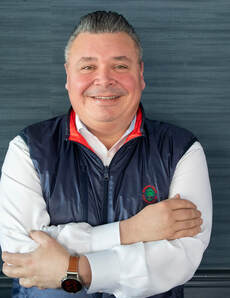 "Working alongside Gerard Clinton, Executive Chef at Aspetuck Valley Country Club, has been an enriching experience from a General Manager's standpoint. Gerard is not only a classically trained chef with an impressive pedigree, honing his skills alongside culinary legends like Christian Bertrand and David Burke, but also a visionary leader in the kitchen. As a classically trained chef, it has been gratifying to watch his creativity coming out of the kitchen. His tenure at Aspetuck Valley has been marked by a profound transformation of the club's culinary landscape. He fosters a mentor-mentee environment in the kitchen, emphasizing the importance of education, skill development, and the value of paying it forward, a philosophy he embodies daily. His ability to recognize and nurture talent has elevated the team's capabilities and contributed to a highly motivated and cohesive kitchen staff. As a General Manager, witnessing the club's culinary reputation flourish under Gerard's stewardship and the marked increase in member satisfaction is profoundly gratifying. Gerard's philosophy that "food has an inherent logic that evolves from tradition," coupled with his innovative strategies and commitment to tradition and quality, truly sets him apart as a chef and a culinary leader." ~Renaud Ammon, General Manager The Metropolitan Club Foundation indeed has a noble mission. It aims to support and advance the club management profession through various educational programs, financial assistance, and professional opportunities. The foundation promotes club management and hospitality in New York and beyond by collaborating with academic institutions and other organizations.
Additionally, the foundation provides crucial support to club management professionals and their families during times of need, such as illness, disaster, or the loss of a family member. This comprehensive approach fosters professional growth and contributes to the well-being of those dedicated to the club management industry. On March 19th, 2024, I attended the 28th Met Club Foundation Vendor Event at Glen Island Harbour Club in New Rochelle, NY. This year's event was very well attended by the who's who of private club industry decision-makers. Many vendors traveled nationwide to showcase their products and services and network with their peers. (Vendor Show Vendor Directory - Metropolitan Club Foundation (metcf.org) Many attended specialized workshops before a buffet-style brunch was served from 11 to 12 noon by the Glen Island Harbour Club culinary team. A successful vendor showcase followed. After a productive afternoon, the Club Chefs of Westchester served up a fabulous array of culinary delights from the culinary teams at Sunningdale Country Club, Blind Brook Club, Rolling Hills Country Club, Shenorock Shore Club, Southward Ho Country Club, Manursing Island Club, American Yacht Club, Hampshire Country Club, Siwanoy Country Club, Wykagyl Country Club, Brae Burn Country Club, Scarsdale Golf Club, Coveleigh Club, Metropolis Golf Club, The Apawamis Club, Mount Kisco Country Club, Old Oaks Country Club. (Sponsors - The Chefs' Warehouse, Paganos, Baldor, Fischer & Miller, Rivera Produce, Sysco, Paris Gourmet, Gordon's Food Service, Downtown East Seafood, McGregor Meats and Grey Bar) I noticed an optimistic atmosphere among those who attended the event this year. Vendors and industry folk were more enthusiastic and engaged, emphasizing the growth of the golf business. "Heather Apgar from the Metropolitan Chapter approached us about attending the M.C.F. Vendor Show at last year's C.M.A.A. Conference in Orlando. As a cost management consultancy that helps clubs around the country lower their food purchasing costs, it felt like a no-brainer based on the Show's focus. Little did we know before attending how beneficial this event would be for our business and how much we would enjoy this unique event. From the fantastic food from the club culinary teams at the reception to the opportunity to tell our story to some of the country's most prominent and most respected club managers, it is easily one of our favorite events on the calendar each year. However, one of the greatest takeaways from this event has been the friends we have made in the industry, whom we now look forward to seeing each year and being able to support the foundation at the same time. Every year, this is a staple on our travel calendar and will be moving forward." Zachary McCarthy, Chief Executive Officer at Club Capital Group. "The Vendor Show, sponsored by the Metropolitan Club Foundation (M.C.F.), is like a homecoming - vendors, club managers, friends, and colleagues gathering at the start of the season. M.C.F., as a result of the Vendor Show and other efforts, has distributed tens of thousands of dollars to families in need and for professional education and scholarships. The Vendor Show helps support M.C.F. As a Trustee of M.C.F., I am most grateful to the Vendors and all the Club professionals who support the Show." Colin Burns, Director at GGA Partners, Senior Advisor at APOGEE, Trustee at M.C.F. "We love attending the M.C.F. Vendor event every year. We've developed a close relationship with Private Clubs and their culinary teams; they feel like family to us. This event is an excellent opportunity for us to come together once a year, celebrate each other's successes, and discuss our goals. As vendors for several years, we've been to many shows. However, only some are as exclusive and focused on working together, building partnerships, and achieving our goal of owning the plate and assisting the M.C.F with their essential fundraising initiatives. We're grateful for our partnership with M.C.F. and feel honored to be part of their culinary world. Thank you!" Jeff Aldana, Regional Sales Manager at The Chefs' Warehouse. ***If you are a vendor or a private club, this event is one to schedule on your team's calendar if you are looking to support a meaningful foundation while showcasing your brand to the right people. Inquiries for 2025- http://www.metcf.org/vendor-show.html Recipe by Finbar Higgins, Executive Chef at K Club, Country Kildare, Ireland, 2015. Photo by Diana DeLucia Serves: 6 Ingredients Smoked Salmon Roulade
Citrus Emulsion
Orange Pearls
Blinis
Citrus Dressing
Garnish
Preparation Smoked Salmon Roulade Put the cream, oak-smoked salmon, horseradish, and cayenne pepper in a pot and bring to a boil. Remove from heat, transfer to a Hotmix-PRO blender or similar, and blitz. Check and adjust the seasoning, pass the mixture through a chinois or a sieve, and then transfer the mixture to a bowl. Squeeze excess water from the gelatin leaves and add them to the mixture. Allow to cool slightly. Quickly fold in the chopped chives and the whipped cream. Transfer the liquid to a piping bag and leave to set in the fridge for 30 minutes. On a bench, lay out two lengths of cling film, each 16 inches long. On each one lay 3 long strips of sliced smoked salmon to cover a 12-inch length of cling film. Pipe a length of cooled salmon cream mix (0.8 inch thick) along the center of each strip of salmon. Picking up the edge of the cling film, roll the salmon into a tight roll and tie each end tightly with string (like a Christmas cracker). Place the rolls in the freezer and, when set, cut each one into three 4-inch lengths and defrost for use. Citrus Emulsion Pour the juices of the citrus fruit into a pot and bring to a boil. Reduce heat and cook until reduced by 80%. Pass the juices through a chinois or fine sieve. Place the juice and mustard in a blender and slowly add the oils as you blitz the mix on a high setting. Once blended, check the seasoning and leave to cool. Orange Pearls Place the orange juice in a pot and bring to a boil, then reduce heat and cook until reduced by 50%. Whisk in the agar agar and champagne, then remove from heat and allow to cool to 54°C—place in a disposable piping bag. Nip a tiny cut at the tip of the bag to allow a very small amount to leak out. Pipe the whole bag of liquid into the container of chilled oil, and you will see the little orange pearls form and set as they sink to the bottom of the oil. Pass the oil through a sieve to extract the pearls and wash off the excess oil with cold water. Set the pearls aside, ready for use. Blinis Add the milk and yeast to a small pot and heat, but do not boil. Mix the strong flour and egg yolks in a separate bowl, and then add the warm milk and yeast. Whisk to combine and pass through a sieve to remove any lumps if required. Whisk the egg whites until stiff in a separate bowl, then fold into the mix. Pour the batter into a siphon gun, add one charger of ISI gas, and shake the bottle well. Release the batter mix directly from the siphon gun onto a heated non-stick pan to make the blinis. Once the pan has come up to temperature, squeeze out four 3cm discs of batter, each one directly below the other, to form one rectangular-shaped blini. Cook until golden brown on each side and set aside to keep warm. Repeat to make 6 blinis. Citrus Dressing Pass the fresh juices through a fine sieve. Place a small pot over high heat and boil until reduced to about 9 oz. Set aside to cool. Mix in the rapeseed oil and season with salt and pepper. Assembly Place 5 grapefruit segments on a plate, then layer a warm blini on top. Place 7 dots of citrus emulsion to the side. Dress the micro-greens with a little citrus dressing and pinch the leaves into a neat pile on the plate with a small mound of orange pearls. Place the piece of salmon roulade on top of the blini and serve. Wine Match Pierre Vessigaud Pouilly-Fuissé, Vielles Vignes, 2015 Straffan House, one of the most exclusive and luxurious holiday rentals in Ireland nestled on 550 acres of countryside located on the grounds of The K Club. Image courtesy K Club.
Stamford, CT (March 14, 2024) – The Chefs’ Warehouse, a leader in the distribution of specialty food products to chefs and culinary enthusiasts, has joined hands with Golf Kitchen Magazine to help bring well-deserved recognition to much appreciated culinary teams across the nation.
The partnership between Chefs’ Warehouse and Golf Kitchen represents a significant step towards enhancing the culinary experience of club industry professionals and enthusiasts. By combining the expertise of Chefs’ Warehouse in providing high-quality, artisanal products with Golf Kitchens extensive industry knowledge, the collaboration aims to bring much-deserved accolades and interest to the club industry. As part of this partnership, future club industry customers of Chefs’ Warehouse will learn more about their expanded product portfolio, allowing culinary teams to experiment with new ingredients, flavors, and techniques, elevating their culinary creations to new heights. "We are thrilled to announce our partnership with Chefs’ Warehouse," said Diana DeLucia, Founder of Golf Kitchen Magazine. Their commitment to quality, innovation, and customer satisfaction aligns perfectly with our values, and we are excited to bring their exceptional products to our customers." "Through our partnership with Golf Kitchen Magazine, we are excited to further expand our reach within the private golf and country club industry, providing culinary teams with access to our premium, artisanal products. We believe that by offering these high-quality ingredients, we can inspire creativity and innovation, ultimately enhancing the dining experience for club members nationwide,” stated Matthew Mosebrook, Regional Vice President of Metro New York. # # # About Chefs’ Warehouse: Founded in 1985, Chefs’ Warehouse is a leading distributor of specialty food products to chefs, culinary professionals, and enthusiasts worldwide. With a focus on quality, innovation, and customer satisfaction, Chefs’ Warehouse offers a curated selection of artisanal products, from premium meats and seafood to specialty cheeses and condiments. For more information about Chefs’ Warehouse, please visit www.chefswarehouse.com. About Golf Kitchen Magazine: The beautifully produced magazine is targeted to chefs, purveyors, general managers, and culinary enthusiasts. Since 2014, Golf Kitchen has chronicled private golf and country clubs, shining a light on the quality of their culinary programs. The Golf Kitchen portfolio includes a quarterly magazine, books, special culinary events, and the Golf Kitchen Culinary Excellence Awards, an annual event at GlenArbor Golf Club, in Bedford Hills, New York. For more information about Golf Kitchen please visit www.golfkitchen.com. Media Contact: Diana DeLucia Founder Golf Kitchen Magazine [email protected] (860) 406 1782 We have developed a culture of pride in what we prepare.Image left to right: Kevin LaFemina, Chef de Cuisine; Derin Moore, CMC; Mehmet Korkmaz, Lead Line Cook; Olcay Gul Koc, Lead Line Cook and Dogukan Duru, Outlet Supervisor. Executive Chef Derin Moore’s Journey & How He Pays it Forward at Grey OaksBecoming a Certified Master Chef (CMC) is a prestigious achievement requiring hard work, dedication, and talent. Mentors can make the journey much smoother, providing a way for aspiring chefs to learn from experienced professionals and gain valuable industry insights. Mentors share their experiences, knowledge, and skills, helping their mentees develop a culinary style and refine their techniques. Additionally, mentoring provides accountability, making the mentee more likely to stay on track and follow through on commitments. The key to achieving the CMC designation is selecting the right chefs. Recently, Golf Kitchen’s founder, Diana DeLucia, sat down with Derin Moore, CMC, at Grey Oaks Country Club in Naples, Florida, to learn about his journey from mentee to mentor. GK: Where did your interest in becoming a Certified Master Chef originate? My grandfather significantly influenced me in my choice of a culinary career. I spent most of my summers with him in Buffalo, New York. He knew Joseph Amendola, the patriarch, instructor, and ambassador of the Culinary Institute of America (CIA) in Hyde Park, New York. In 1982, when I was in the 10th grade, my grandfather took me on a CIA campus tour. I met many chefs of this era, including Tim Ryan and Mark Erickson, who were department heads under Ferdinand Metz, President of the CIA for 21 years. I was accepted to the CIA after graduating from high school. Most people there were older and working towards a second career, while I was just 18 years old. Moving from Detroit to New York State was a big change for me. I was timid and buried myself in my studies. Since most of my classmates were older and more exper- enced, I looked to my instructors for guidance. This is when I first learned about Master Chefs and the Culinary Olympics. While at the CIA, I completed an 18-month study, including a five-month externship at The Bijou restaurant, ultimately graduating in 1986. Following graduation, I worked in a few kitchens that were not at the level I had grown accustomed to at the CIA and found that I needed more guidance and experience. A colleague introduced me to Brian Polcyn, an accomplished chef who had written several books on charcuterie, coauthored by Michael Ruhlman. Brian, who is an incredible chef took me under his wing and mentored me through the ranks of his kitchen, eventually to become Chef de Cuisine running day-to-day operations while he opened two other restaurants. At a young age, I oversaw one of the best fine-dining restaurants in Michigan under his leadership. I stayed with Brian for eight years, where I built a strong foundation based on the fundamentals of solid cooking. It was Brian who encouraged me to compete in regional culinary competitions, which I did in Cleveland, Chicago, and Detroit. Several Master Chefs from my home state of Michigan participated on regional and national Culinary Olympic teams, including Mike Russell, Dan Hugelier, and Jeff Gabriel. World-renowned Master Chef Milos Cihelka mentored many of the successful Michigan chefs. I looked up to all of them, knowing that this was the challenge I wanted. Their mentoring would later spark my interest in representing the United States in international competitions. Being part of U.S. Culinary Olympic Team, training and getting ready to take the Master Chef exam at the CIA, opened up an entirely new level of relationships with chefs interested in seeing me succeed. GK: What are the key lessons you have learned during your career? I will never improve if I surround myself with people who just accept what I do without challenging me to be better. One of the first menus I wrote when I became Chef de Cuisine under Brian was very aggressive and creative. However, the crew could not execute it, service needed to be faster, and they needed help to get the food out of the kitchen. Brian allowed me to make that mistake. It was a valuable lesson: Don’t be overly creative if the team that surrounds you is not trained first to execute it. GK: What did you learn from competing? Love of competition is more than simply winning a medal. It’s striving to be perfect. And that philosophy has spilled over into my work ethic. During the competition, you spend all this time making a beautiful piece. Then you slice it the wrong way, and suddenly, you’ve slipped to a silver or bronze medal. That constant reinforcement and emphasis on perfection is what competition is all about. GK: How did you prepare for the ten-day CMC exam? One misconception of preparing for the exam is that you suddenly start to study and cram. But it’s the choices you make along the way that prepare you, who trains you, constant refinement of your skills, competing, researching, and strengthening weaknesses in preparation or style. Fritz Gitschner, CMC, was Executive Chef at Houston Country Club and a stern judge at the CMC exam. He was notorious for low scores and a stickler for details, flavor, and sanitation. I needed to know the nuances of the exam to pass. To take the mystery out of it, I decided to call him. He told fellow chef Dan Scannell and me to come to Houston and he would put us through every segment of the Master Chef exam. After each morning and afternoon session, he critiqued our work, how we moved in the kitchen, organized our stations, and sanitation. He pointed out our bad and good habits. He had vested interest in our success, but we also made a considerable commitment for a solid week. GK: What was the most challenging part of the exam? Day ten of the exam is critical. While the first nine days of the exam are worth 60% of the total score, day ten is a mystery basket weighted at 40%. We drew a list of 15 different ingredients and had 20 minutes to create a menu, 10 minutes to requisition the food, four hours to cook, and 20 minutes to serve twelve portions. At the end of the ninth day, Peter Timmons, CMC, who was the Executive Chef at The Greenbrier in White Sulphur Springs, WV, pulled me aside and said, “You know you have a good shot at passing. How are you organizing yourself for the mystery basket portion?” He explained the importance of organizing your thoughts for quick decision-making and ultimate success. Again, this proved to be valuable advice from a trusted mentor. GK: Tell us how Lawrence McFadden became a mentor and friend? I was on the U.S. Culinary Olympic Team with Lawrence from 1993 to 1996, and we developed a professional relationship. He went on to serve as Executive Chef and Corporate Chef with the Ritz-Carlton Hotel Company. n 2007, while I was at Medinah Country Club, Lawrence called and asked if I would be interested in becoming the Executive Chef for the Ritz-Carlton in Naples. We had a discussion about the inner workings of the resort and he told me, “You can manage 25 outlets, and your vision of food is what we need to take the property to the next level.” I got the job, which was my first post at a five-star, five-diamond luxury resort. Lawrence gave me a stellar opportunity and for the next several years, over daily cups of coffee, we challenged each other to be better than the day before. He’s been a great friend and a significant influence. GK: Many younger chefs only have some of this experience, and some have just worked their way up in one country club. How do they gain access to this level of mentorship and opportunities? When somebody tells me they want to be a Master Chef or asks me what it takes to be one, I must be honest with them. It was not just about taking the exam; it was a compilation of every experience I had along the culinary journey with my mentors. It’s all the travels, hard work, successes, and failures. GK: How has social media changed culinary communications and promotion? Social media brings exposure and gives chefs a platform to share information. Chefs striving for perfection have an outlet to solicit feedback. GK: Your team at Grey Oaks is a very diverse group of cooks from around the world. What effect has your mentoring program had on them? They appreciate the opportunity to learn, while challenging themselves and growing their craft. The positive impact of our mentoring program also transcends the culinary realm, including creating a workplace culture that values diversity and celebrating the unique contributions of each person. In turn, team members eagerly recommend Grey Oaks to their vast network of colleagues in the industry and the Club is then able to hire similar driven culinarians who want to learn and succeed. Image courtesy Grey Oaks Country Club, Naples, Florida, USA
|
